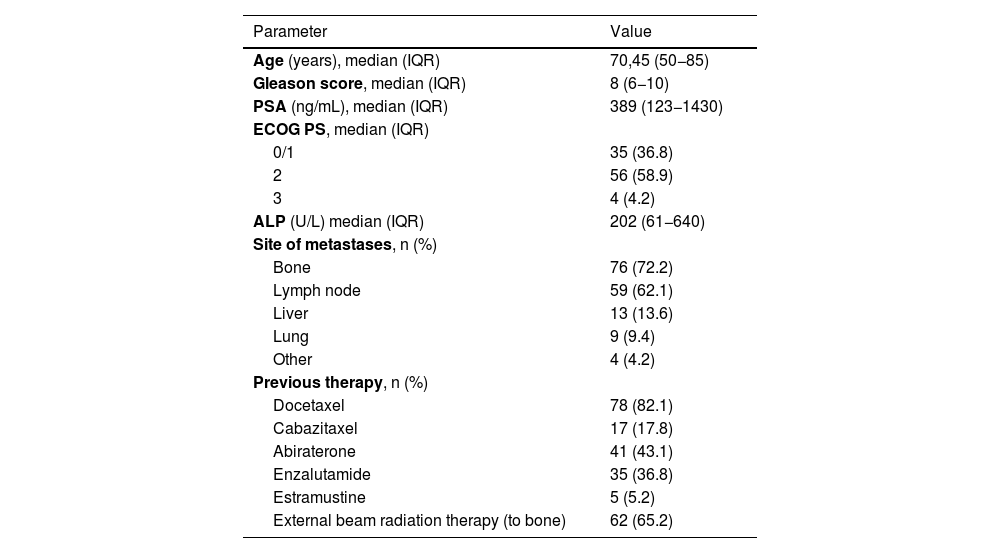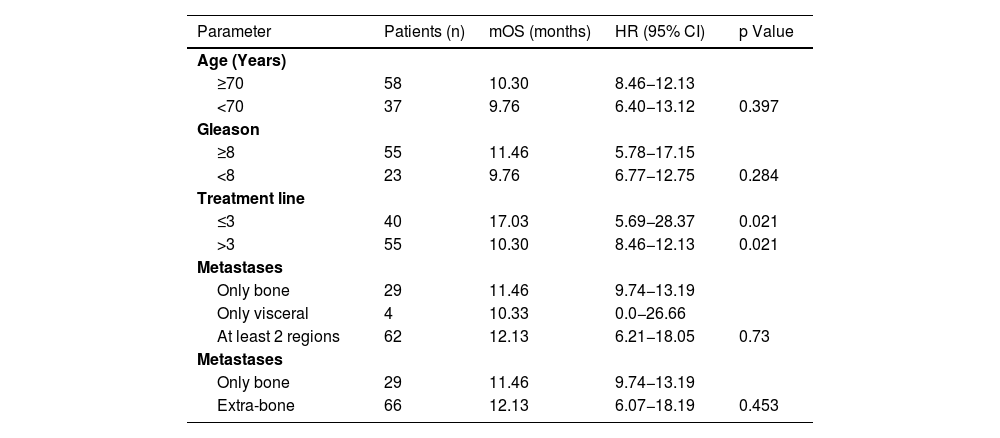Radioligand therapy which targets the prostate specific membrane antigen (PSMA) has recently considered as option in the treatment of metastatic castration resistant prostate cancer (mCRPC). The aim of this study was to evaluate the biochemical, clinical and radiological data of patients received treatment with 177Lu-PSMA-617 RLT in our clinic following the diagnosis of mCRPC, and to investigate the relationship between treatment timing and metastasis region and survival.
Material and methodsThis is a retrospective, observational, single-center study from December 2016 to December 2019. Patients underwent 177Lu-PSMA-617 RLT with a diagnosis of mCRPC. We used the Kaplan–Meier test and the Cox regression proportional hazard test to assess survival data.
Results95 patients with an average age of 70.45 (50−85) were evaluated retrospectively. Median follow-up was 10.86 months (8.15–11.94 months) and the median lines of 177Lu-PSMA-617 RLT treatment was 4 (1–5). Median overall survival was found to be 17.03 ± 5,78 months in the patients receiving the treatment at the third or lower lines while it was 10,30 ± 0,93 months in patients receiving the treatment at the fourth or higher lines (p = 0.021). When evaluating patients with only bone metastasis and patients with bone and lymph node metastasis, the median overall survival was 11.46 ± 0.87 months and 12.13 ± 3.02 months (p = 0.445), respectively.
Conclusion177Lu-PSMA-617 RLT treatment provides better survival in the treatment of patients diagnosed with mCRPC after standard treatments and received it earlier. 177Lu-PSMA-617 RLT treatment could be an effective treatment method in mCRPC patients with bone and lymph node metastasis.
La terapia con radioligando que se dirige al antígeno de membrana específico de la próstata (PSMA) se ha considerado recientemente como una opción en el tratamiento del cáncer de próstata resistente a la castración metastásico (mCRPC). El objetivo de este estudio fue evaluar los datos bioquímicos, clínicos y radiológicos de los pacientes que recibieron tratamiento con 177Lu-PSMA-617 RLT en nuestra clínica tras el diagnóstico de mCRPC, e investigar la relación entre el momento del tratamiento y la localización de las metástasis y la supervivencia.
Material y métodosEste es un estudio observacional retrospectivo realizado en un único centro de diciembre de 2016 a diciembre de 2019. Los pacientes se sometieron a tratamiento con 177Lu-PSMA-617 RLT con un diagnóstico de mCRPC. Usamos la prueba de Kaplan–Meier y la prueba de riesgo proporcional de regresión de Cox para evaluar los datos de supervivencia.
ResultadosSe incluyeron 95 pacientes con una edad promedio de 70,45 (50−85). La mediana de seguimiento fue de 10,86 meses (8,15−11,94 meses) y la mediana de las líneas de tratamiento con 177Lu-PSMA-617 RLT fue de 4 (1–5). Se encontró que la mediana de supervivencia global fue de 17,03 ± 5,78 meses en los pacientes que recibieron el tratamiento en la tercera línea o líneas inferiores, mientras que fue de 10,30 ± 0,93 meses en los pacientes que recibieron el tratamiento en la cuarta línea o más (p = 0,021). Al evaluar a los pacientes con metástasis únicamente óseas y a los pacientes con metástasis óseas y ganglionares, la mediana de supervivencia global fue de 11,46 ± 0,87 meses y 12,13 ± 3,02 meses (p = 0,445), respectivamente.
ConclusiónEl tratamiento con 177Lu-PSMA-617 RLT proporciona una mejor supervivencia en el tratamiento de pacientes diagnosticados con mCRPC después de tratamientos estándar y que lo recibieron antes. En los pacientes con mCRPC el tratamiento con 177Lu-PSMA-617 RLT presenta mejor supervivencia si se realiza antes de la cuarta línea de tratamiento estándar. El tratamiento con 177Lu-PSMA-617 RLT podría ser un método de tratamiento eficaz en pacientes con mCRPC con metástasis óseas y ganglionares.
Article

Revista Española de Medicina Nuclear e Imagen Molecular (English Edition)













